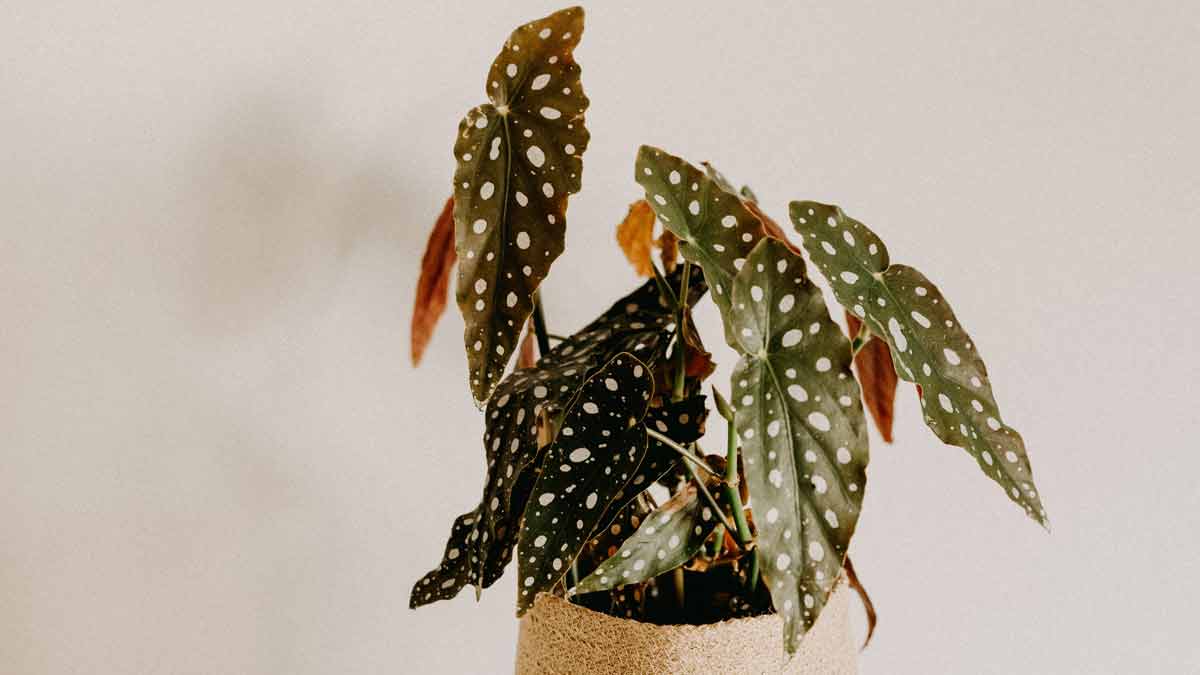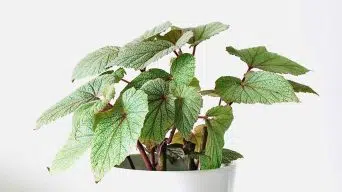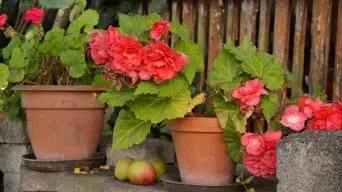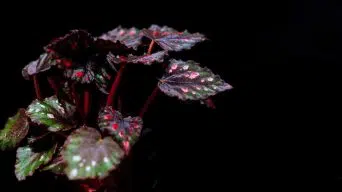One of the most common causes of begonia leaves falling off is improper watering practices. If you’re overwatering or underwatering your plants, it can cause plant stress and lead to leaves dropping off. Improper sunlight and temperature can also contribute to leaf loss, as can pest infestations, fungal diseases, and nutrient deficiencies.
Begonia plants, like the Angel wing begonia, the Begonia maculata, or the Polka dot begonia, are native to tropical and sub-tropical regions of the world.
They are popular houseplants because they are relatively easy to care for and come in various colors and shapes.
One common problem begonia owners face is begonia leaves falling off.
There are several reasons why this may happen; fortunately, you can also do some things to resolve it.
Here are some of the most common reasons begonias leaves may fall off and what you can do about each one:
What Causes Begonia Leaves To Fall Off?
The most common reasons begonia leaves fall off are:
Overwatering
One of the most common reasons begonia leaves fall off is because of overwatering.
Begonias are tropical plants that like to be kept moist but not soggy.
Overwatering your begonia or letting it remain in stagnant water may lead to the dropping of begonia leaves.
To fix this, only water your begonia when the top inch of soil is dry.
It is also a good idea to use a well-draining potting mix and ensure adequate drainage in the pot.
Underwatering
Another common reason begonia leaves fall off is because of underwatering.
The leaves will turn yellow and fall off if you do not water your begonia enough.
Begonias must be watered at least once a week and more often if the weather is hot and dry.
To fix this, ensure you water your begonia enough and the pot has good drainage.
The best way to water begonias is to dunk the pot in a sink or bucket of water and let it soak for a few minutes. Then, allow the pot to drain before putting it back on the saucer or plant stand.
This will help ensure that the begonia gets enough water without being overwatered.
Extreme Temperatures
Another common reason begonia leaves may fall off is because of extreme temperatures.
If the temperature gets too hot or cold, begonia leaves will turn yellow and fall off.
To fix this, avoid exposing your begonia to extreme temperatures.
Begonias thrive in temperatures between 65 and 75 degrees Fahrenheit.
If the external temperature is excessively high or low for begonias, it is advisable to maintain them indoors.
Indoor begonias should be kept away from drafts, heaters, and air conditioners to prevent the leaves from falling off.
Not Enough Light
Begonias need bright, indirect light to thrive. If they do not get enough light, the begonia plant will start to stretch, and the leaves will fall off.
Begonias need at least four hours of indirect sunlight daily, but they can tolerate up to eight hours.
To fix this, make sure you are giving your begonia enough light.
Place the begonia near an east- or west-facing window. This will give the begonia the bright, indirect light it needs without exposing it to direct sunlight, which can be too harsh.
You can also use a grow light to give your begonia the extra light it needs.
Too Much Sunlight
While begonias need bright indirect light to thrive, too much direct sunlight can cause begonia leaves to fall off.
If the begonia is exposed to direct sunlight, the leaves will sunburn and turn brown or red.
Eventually, the leaves will fall off.
To fix this, ensure you are not exposing your begonia to direct sunlight.
A window facing east or west is the best place for the begonia. This will give the begonia indirect sunlight without exposing it to direct sunlight.
You can also use a sheer curtain or blind to filter the light if you need to place the begonia in a south-facing window.
Soil Issues
If the begonia is in well-draining soil, this can prevent begonia leaves from falling off.
Water that sits around the begonia plant can lead to root rot, killing the indoor plant and causing the leaves to fall off.
To fix this, ensure you are using a well-draining potting mix and that the pot has adequate drainage.
You can also add a layer of gravel or pebbles to the bottom of the pot to help with drainage.
Pest Infestation
If begonias are infested with pests, this can also cause begonia leaves to fall off.
Pests such as worms, aphids, mealybugs, and whiteflies feed on begonia plants and can cause the leaves to fall off.
To fix this, you must treat the begonia plant for pests.
You can do this by spraying the begonia with an insecticidal soap or neem oil solution.
You must spray the begonia plant every few days until the pests are gone.
Nutrient Deficiency
If begonias are not getting the nutrients they need, this can also cause begonia leaves to fall off.
Begonias need a well-balanced fertilizer to thrive. If they do not get enough nutrients, the begonia plant will start to show yellowing leaves that eventually will drop off.
To fix this, you will need to fertilize the begonia plant.
Fertilize begonias every two weeks with a well-balanced fertilizer during the growing season.
During the winter, you can fertilize begonias every month.
Diseases
If begonias are infected with a plant disease, this can also cause begonia leaves to fall off.
Some common diseases that affect begonias include powdery mildew, root rot, and bacterial leaf spot.
Powdery mild is a white powdery fungus that grows on the leaves of begonias.
Root rot is caused by too much water and can kill begonia plants.
Bacterial leaf spot is a bacterial infection that causes black or brown spots on begonias leaves.
To fix this, you will need to treat the begonia plant for the disease.
You can treat the begonia plant with a fungicide if powdery mildew is present.
If root rot is present, you must reduce watering and ensure the begonia is in well-draining potting soil.
If a bacterial leaf spot is present, you can treat the begonia plant with a bactericide.
Transplant Shock
If begonias are transplanted, this can also cause begonia leaves to fall off.
Transplanting begonias can be stressful for the plant and cause the leaves to fall off. They may also lose their color and stop growing.
To fix this, you must give the begonia plant time to adjust to its new environment.
Refrain from fertilizing the begonias for at least a week after transplanting.
Also, ensure you are not exposing the begonia to direct sunlight or excessive heat.
Give the begonia plant time to adjust to its new environment, and the leaves will stop falling off.
Natural Leaf Drop
In some cases, begonia leaves dropping off is a natural occurrence.
Begonias are known to lose their leaves during the winter months. This is normal, and there is no need to worry.
The lower leaves of begonias will turn yellow and fall off as the plant goes into dormancy.
When the begonia comes out of dormancy, new growth will appear in the spring.
What To Do When Begonia Leaves Fall Off
Now that you know some of the reasons why begonia leaves fall off, you may wonder what to do about it.
Here are some tips on what to do when begonia leaves fall off:
1. Check The Soil
The first thing you should do if begonia leaves are falling off is to check the soil.
Ensure begonias are planted in well-draining soil and the pot has adequate drainage.
You can also add a layer of gravel or pebbles to the bottom of the pot to help with drainage.
2. Check For Pests
If begonia leaves are falling off, it could be due to pests.
Check your begonias for signs of worms, aphids, mealybugs, and whiteflies.
If you find pests on begonias, you must treat the plant with an insecticidal soap or neem oil solution.
3. Check The Fertilizer
A nutrient deficiency could be the cause of falling begonia leaves.
Check to see if begonias are getting enough nutrients.
Begonias need a well-balanced fertilizer to thrive.
Fertilize begonias every two weeks during the growing season. Use a half-strength fertilizer and water begonias before and after fertilizing.
4. Check For Diseases
A disease could be causing begonia leaves to fall off.
You should check begonias for diseases such as powdery mildew, root rot, and bacterial leaf spot.
If you find a disease in begonias, you must treat the plant with the appropriate fungicide.
5. Check The Temperature
If begonia leaves are falling off, it could be due to the temperature.
Begonias do not like extreme heat or cold.
Make sure begonias are not being exposed to direct sunlight or excessive heat.
Also, make sure begonias are kept in a warm place.
6. Check The Watering Schedule
Watering too much or too little can cause begonia leaves to fall off.
Water begonias when the top inch of soil is dry.
Do not let begonias sit in water, which can cause the roots to rot.
Also, make sure begonias are not being underwatered.
7. Check The Light
Light problems could be causing begonia leaves to fall off.
Begonias need bright, indirect sunlight to thrive.
Make sure begonias are not exposed to direct sunlight, which can scorch the leaves.
Place begonias in a place where they will get bright, indirect sunlight.
East- or west-facing windows are ideal.
8. Give The Begonia Plant Time To Adjust
If begonia leaves are falling off, it could be due to transplant shock.
When begonias are transplanted, they can lose their leaves.
This is normal, and the begonia plant will need time to adjust to its new environment.
Do not fertilize begonias for the first few weeks after transplanting.
9. Prune The Begonia Plant
If begonia leaves are falling off, it could be due to overgrown begonias.
Begonias can become leggy and fall over if they are not pruned.
Prune begonias in the spring to encourage new growth.
10. Check The Humidity
If begonia leaves are falling off, it could be due to the humidity.
Begonias need high humidity to thrive.
Place begonias in a room with a humidifier or mist begonias regularly with water.
You can also place begonias on a pebble tray to increase the humidity around the plant.
How to Prevent Begonia Leaves from Falling Off
You can do a few things to prevent begonia leaves from falling off.
- Water begonias regularly and do not allow the soil to dry out.
- Place begonias in an area where they will get bright, indirect sunlight.
- Fertilize begonias every two weeks with a well-balanced fertilizer during the growing season.
- Prune begonias regularly to encourage new growth.
- Avoid transplanting begonias unless it is necessary.
- Check begonias regularly for pests and diseases and treat them accordingly.
By following these tips, you can prevent begonia leaves from falling off.
What Are The Benefits Of Begonia Dropping Their Leaves?
While it may be alarming to see begonia leaves falling off, it is a good thing. Leaf drop is a natural process that begonias go through to conserve energy.
When begonias are not getting enough light, they drop their leaves to prevent the plant from wasting energy.
Leaf drop is also a way for begonias to eliminate old, damaged leaves. By dropping their leaves, begonias can focus their energy on new growth.
While leaf drop can be alarming, it is a natural process that begonias go through.
What To Do With Begonia Leaves That Have Fallen Off
If begonia leaves have fallen off, there is no need to worry. Begonia leaves that have fallen off can be composted.
Add the begonia leaves to your compost pile, which will break down over time.
You can also add begonia leaves to your garden as mulch. The begonia leaves will help to retain moisture in the soil and protect the roots of your plants.
If begonia leaves have fallen off, there is no need to worry. Begonia leaves that have fallen off can be composted or used as mulch.
By composting or using begonia leaves as mulch, you can help your begonias to thrive.
Final Thoughts
If begonia leaves are falling off, it’s essential to try to determine the cause so that you can take steps to fix the problem.
Sometimes, begonias need more water or humidity. Other times, pests or diseases may be to blame.
By taking a closer look at your begonia and making some simple changes to its care, you can often get it back on track and enjoy healthy growth again.







